Our return to the Barnes Wallis building showcased some of the best layouts in the country and included the two biggest that we have exhibited at this venue.
Here is a video of some for the 2017 exhibits
Thanks to acw71000 for permission to include this video
Annascaul (OOn3, 4mm=1ft, 12mm gauge)
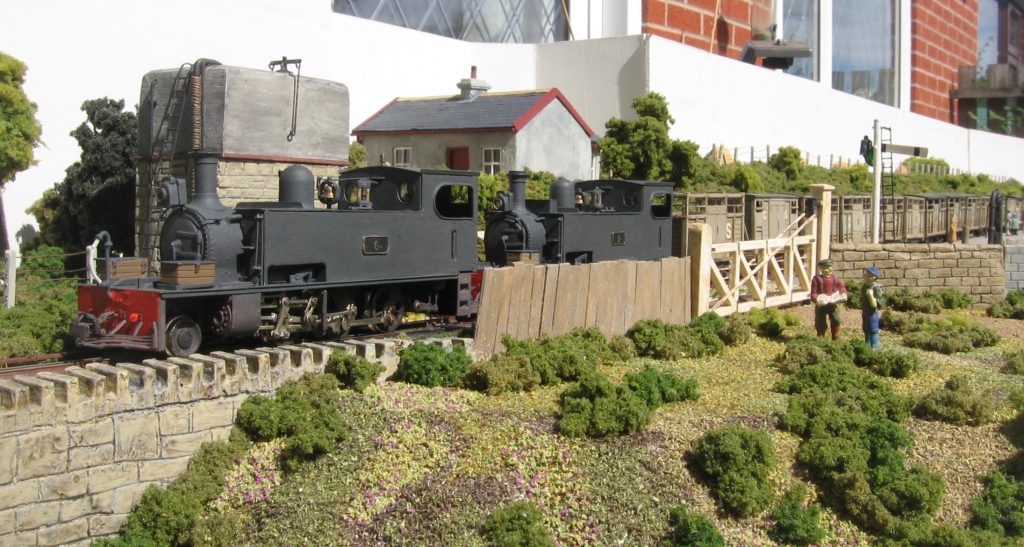
Annascaul (Abhainn an Scail) is a station on the 3ft gauge Tralee & Dingle Light Railway, County Kerry, which opened in 1891 to passengers and goods traffic. Spring 1939 saw the end of passenger trains and the daily goods was discontinued in 1946. This left the once monthly cattle trains as the only source of revenue and these service came to an end in June 1953.
The station was one of two intermediate passing places on the railway. Collecting information for the model has not proved to be as easy as first anticipated and new facts are still coming to light. Lots of photos were taken here by railfans but buildings were obscured by stock and steam and the infrastructure was definitely not of prime concern.
Four trains run representing the T & D. Watch out for others though from Irish lines, the Isle of Man and even French metre gauge.
Banbury (N scale, 2mm=1ft, 9mm gauge)
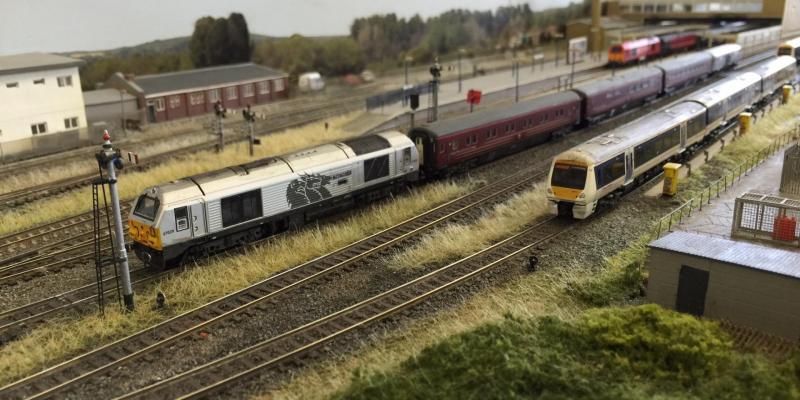
Banbury station lies on a busy cross country route between Birmingham and Didcot, where it joins the Great Western Mainline. The Chiltern Railways mainline towards London Marylebone diverges a few miles South at Aynho Junction. There is a lot of freight traffic, mainly containers to and from Southampton. 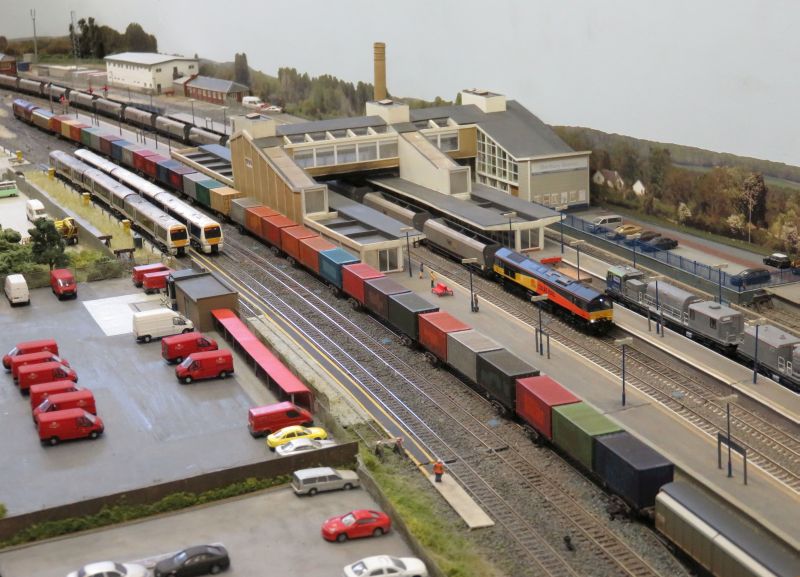 Chiltern Trains operate the majority of passenger services but Cross Country trains have two an hour each way and First Great Western have a local service that terminates at Banbury. Until January 2011 there were Wrexham and Shropshire loco hauled passenger trains. Chiltern Trains have now introduced loco hauled trains on weekdays between London and Birmingham.
Chiltern Trains operate the majority of passenger services but Cross Country trains have two an hour each way and First Great Western have a local service that terminates at Banbury. Until January 2011 there were Wrexham and Shropshire loco hauled passenger trains. Chiltern Trains have now introduced loco hauled trains on weekdays between London and Birmingham.
Peco finescale code 55 track has been used with SEEP solenoids to operate the turnouts. All buildings have been scratch built from plastic sheet and are as close to scale as can be from scaling from photographs. Great use of Google maps and Google Streets has been made to check proportions and locations of buildings relative to each other. Rolling stock and locomotives have been detailed and are from manufacturers such as Graham Farish and Dapol.
Control is via Digitrax Digital Command Control. Turnouts are also controlled via stationary decoders. To control both the trains and turnouts, we use ipods and iphones running an app called Wi Throttle. This then communicates with the DCC system via a wireless router connected to a laptop that runs the free software JMRI. The laptop is connected to the DCC command station using an interface called Loco Buffer. Touch screen PC’s are used for the track plan and turnout control and showing their status.
Bridgwater S&DJR (O gauge, 7mm=1ft)
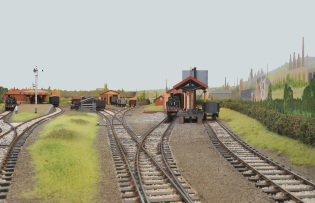 The line from Bridgwater to Edington was opened on 21 July 1890, being built by an independent company, the Bridgwater Railway Co. It had been ‘independent’ in name only having been promoted and operated as an extension to the S&DJR system. The station building was built of local brick and had the appearance of an LSWR design. It stood at right angles to the two-bay island platform, upon which a canopy was built covering over half its length. The goods yard, complete with shed, had ample facilities to handle many commodities including coal, bricks, tiles and livestock. A single road engine shed of brick construction was also built, together with a 50ft turntable in front of its entrance. The shed, although extended in 1898 to accommodate two locomotives, was not used to stable locomotives overnight and was subsequently leased to the Co-op in 1928 for use as a store.
The line from Bridgwater to Edington was opened on 21 July 1890, being built by an independent company, the Bridgwater Railway Co. It had been ‘independent’ in name only having been promoted and operated as an extension to the S&DJR system. The station building was built of local brick and had the appearance of an LSWR design. It stood at right angles to the two-bay island platform, upon which a canopy was built covering over half its length. The goods yard, complete with shed, had ample facilities to handle many commodities including coal, bricks, tiles and livestock. A single road engine shed of brick construction was also built, together with a 50ft turntable in front of its entrance. The shed, although extended in 1898 to accommodate two locomotives, was not used to stable locomotives overnight and was subsequently leased to the Co-op in 1928 for use as a store.
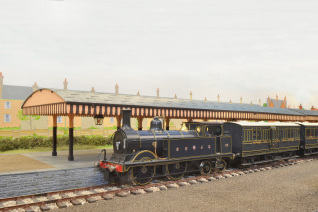
Until 1942 there was a 48 chain (1056 yd) extension from the cattle dock that swung through 180o to provide access to the brickworks and wharf facilities and the east bank of the river Parrett. The station was renamed Bridgwater North in 1949 when it came under British Railways ownership, to avoid confusion with the larger Great Western Railway (GWR) station in the town. When the line to Edington was finally closed in 1954 a new spur was laid from the S&D yard to connect it to the GWR docks branch. The goods yard remained in use until 7 July 1962 and the docks branch finally closed on 2 January 1967.
The station is modelled in the summer of 1904. Further information about Bridgwater can be found at
http://www.bridgwatersdjr.wordpress.com
Camden Shed 1B (O gauge, 7mm=1ft)
Camden MPD! For railway enthusiasts, the very name invokes nostalgic memories of this fascinating place. What boy (or even father) could resist peering out of the window of a passing train to see what was ‘on shed’ that day. Although not particularly large, being the dedicated Motive Power Depot for London’s Euston station, it was one of the few places that top link express locomotives of the LNWR, the LMS or even the early British Railways, could be seen in abundance and in close proximity to one another. Often a smokey place, it was nevertheless a thrill for locospotters to watch the non-stop action from the nearby bridge or if one was so lucky, enjoy a visit to this hall of giants.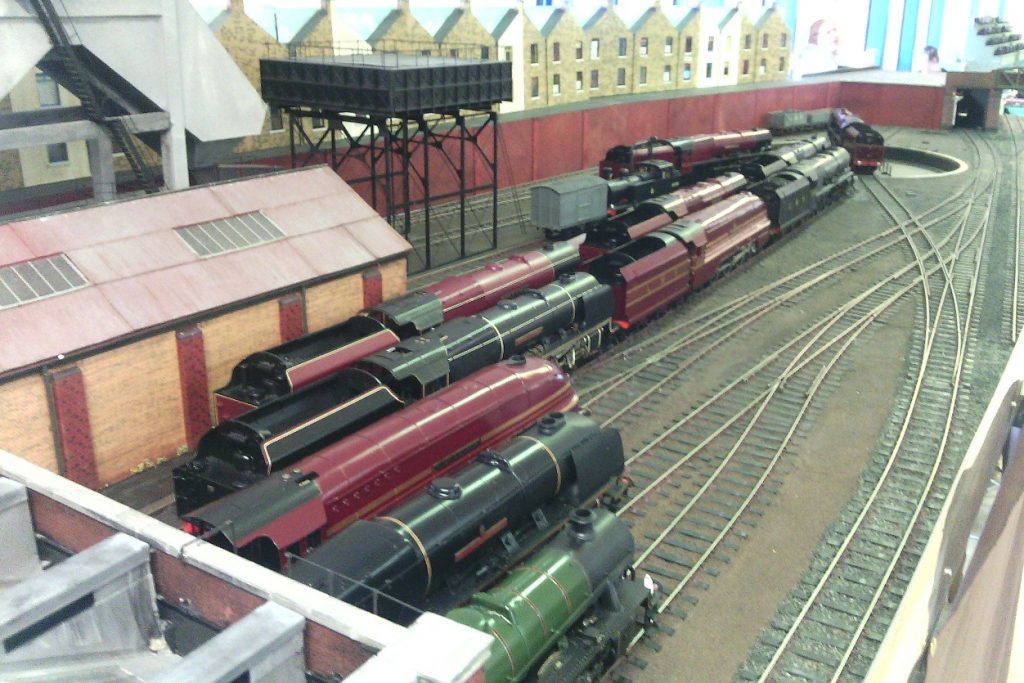
The model shown represents the northwest end of the MPD where most of the action could be witnessed. Locomotives still facing south, enter the depot from the engine line at the left-hand side and proceed tender first, to the turntable. After turning, which takes 11/2 minutes, engines reverse back past the water tank to the coaling plant. After coaling, engines pass behind the shed and workshop to the ash plant where the fire would be cleaned and waste ash discarded into skips for loading into wagons for disposal. Beyond the ashplant locomotives proceed to the headshunt and approach the rear of the depot, chimney-first and now facing northwards, ready for cleaning and minor servicing work before preparation for their next duty. Engines requiring more serious attention are directed into the workshop behind the shed.
All engines worked to ‘diagrams’ which determined their duty usage from day to day between servicing and so it is on the model. The clock shows the time of day and the relevant portion of the Depot Schedule based upon the actual requirements of the LMS Autumn 1947 timetable is displayed alongside the shed so that the onlooker may follow events. Depending upon circumstances, the clock may be stopped or speeded up. As in real life, ‘spotters’ must wait to see which locomotive is allotted to each service.
The period represented is loosely from 1935 to 1947 in order to display the several liveries which LMS locomotives carried before Nationalisation. In real life, few streamliners retained their colourful livery to be seen alongside locomotives of the same class in the 1946 lined black livery.
Camel Quay (OO, 4mm=1ft, 16.5mm gauge)
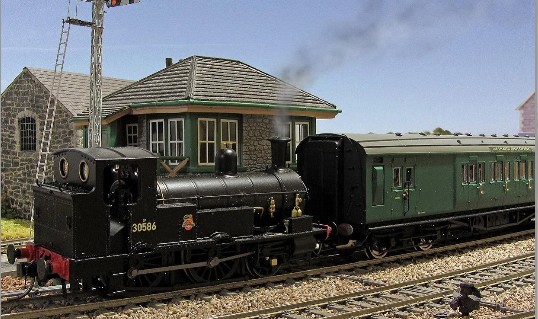 Camel Quay is a typical North Cornwall ex-LSWR station on the River Camel that could have been on the Rock-Delabole Railway had it been built. The station, with its station building, goods shed, and signal box, bears a resemblance to Padstow on the opposite side of the river. There are local pull-push passenger services and trains from Exeter and Waterloo including a portion of the ‘Atlantic Coast Express’. The quay, with its sidings, sustains a small coaster carrying china clay brought down from the local quarry in wagons and a small local fishing fleet. The High Street has a traditional public house, railway hotel and a few shops served by the local Bedford OB bus service to surrounding towns and villages. The era depicted is of the early/late BR period with typical examples of the BWT, O2, M7, T9, ‘N’ and Class 22 locos with ‘Carmine & Cream’ and BR(S) Green/Crimson coaching stock.
Camel Quay is a typical North Cornwall ex-LSWR station on the River Camel that could have been on the Rock-Delabole Railway had it been built. The station, with its station building, goods shed, and signal box, bears a resemblance to Padstow on the opposite side of the river. There are local pull-push passenger services and trains from Exeter and Waterloo including a portion of the ‘Atlantic Coast Express’. The quay, with its sidings, sustains a small coaster carrying china clay brought down from the local quarry in wagons and a small local fishing fleet. The High Street has a traditional public house, railway hotel and a few shops served by the local Bedford OB bus service to surrounding towns and villages. The era depicted is of the early/late BR period with typical examples of the BWT, O2, M7, T9, ‘N’ and Class 22 locos with ‘Carmine & Cream’ and BR(S) Green/Crimson coaching stock.
The layout is DCC controlled and all Locos are sound fitted.
Campbell’s Quarry (16mm=1ft)
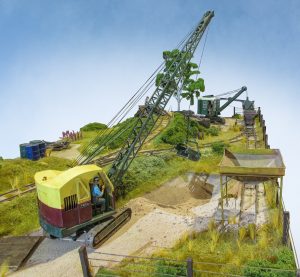 A micro-layout where radio controlled cranes, locos and sand drags move piles of sand around all day!
A micro-layout where radio controlled cranes, locos and sand drags move piles of sand around all day!
Cirencester (M&SWJR) (P4, 4mm=1ft, 18.83mm gauge)
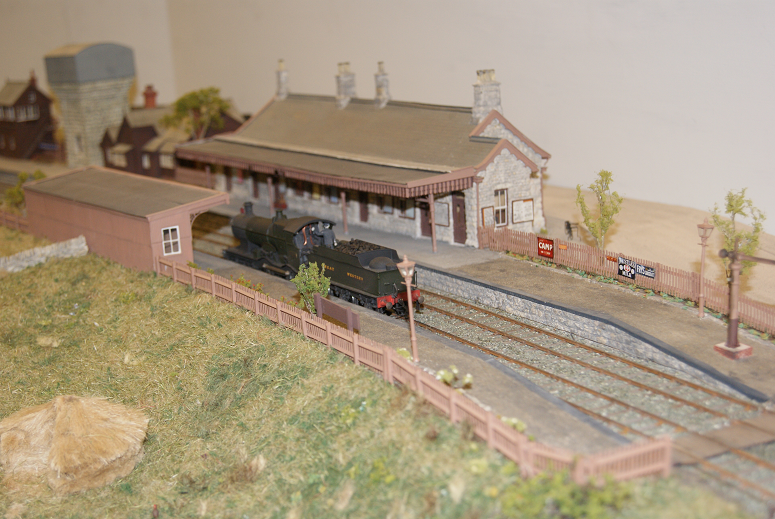
This station in Cirencester should not be confused with the GWR terminus on the other side of town. It lay on the Midland and South Western Junction Railway running between Andover and Andoversford and linked the north and midlands to the south coast, in particular the docks at Southampton.
Running through a mainly rural area, local traffic did not become significant, but as a through line it developed an important use during wartime and for military manoeuvres on Salisbury Plain, providing a vital link for the movement of supplies and men. During peacetime the link to the docks provided income from seasonal fruit and vegetable traffic and to service the port and ships.
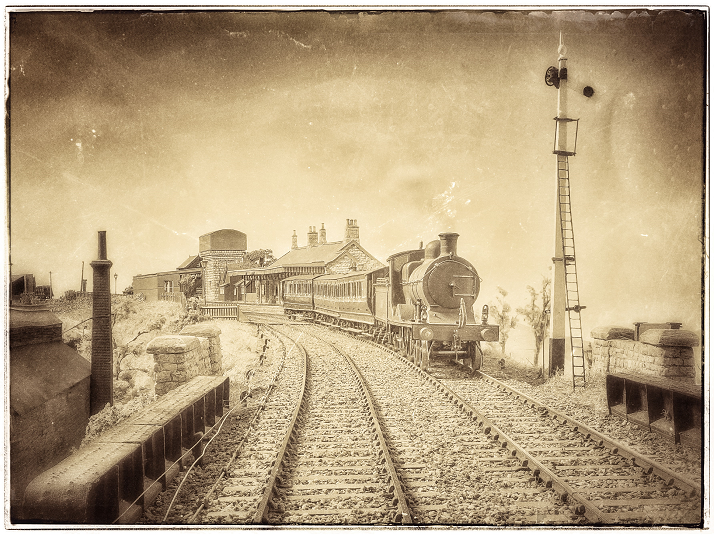
The lack of income meant the company was unable to afford sufficient stock to maintain the service during peace time let alone during wartime and they were frequently forced to borrow from other companies. They were loaned locomotives and coaches by the GWR, MR and the LSWR. During military activity a great variety of stock could appear providing me with a great excuse for modelling almost anything I fancy.
Cirencester was the workshop location for building and maintaining the company’s stock. These are under construction and they will sit behind the main station buildings. To the north, towards Cheltenham, the line is double tracked but to the south only a single line existed. There seem to have been many changes to the track layout, with most plans that I have seen having the access to the siding behind the signal box and the works and goods shed combined, however there is evidence that at one time there were two separate links and this is the configuration I have modelled.
I have tried to date the line at around 1919 which justifies a variety of stock from other companies as well as the MSWJR itself and include some extra unusual movements.
Franklin (On2, 1/48th scale, 1/2in gauge)
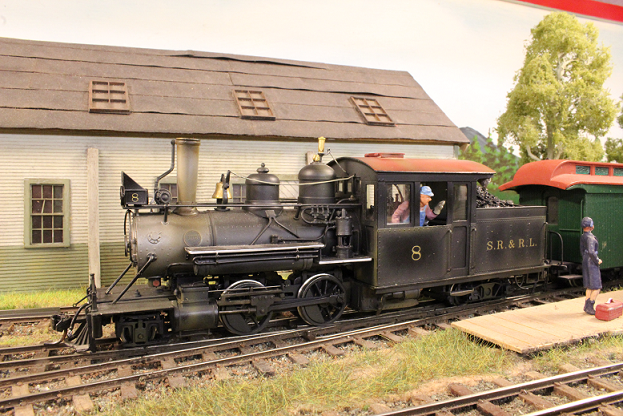 Franklin is the latest part of my foray into North American narrow gauge modelling, and is the portable terminus of a small 2ft gauge branch line up the Kettle River valley. At home, this feeds into my 220ft long 3ft gauge main line depicting narrow gauge operation in the Rockies of British Columbia.
Franklin is the latest part of my foray into North American narrow gauge modelling, and is the portable terminus of a small 2ft gauge branch line up the Kettle River valley. At home, this feeds into my 220ft long 3ft gauge main line depicting narrow gauge operation in the Rockies of British Columbia.
This new section is based on the 2ft lines in Maine, USA, and was originally inspired by the exquisite Bachmann models of the typical Maine Forney tank engines. The station is mainly based on Bridgton, on the Bridgton & Saco River Railroad, but some of the buildings are from the Sandy River & Rangeley Lakes Railroad, both in Maine.
I agonised for some time as to whether I should stick with the Bachmann 00 track gauge of 16.5mm, or re-build the locos and stock to true 2ft gauge, and the masochist in me finally won. Built to American ¼ inch to the foot scale, ie 1/48th, the track is all handbuilt to ½ inch gauge. Some of the locos are re-gauged Bachmann, whilst the rest are brass imports from the Far East. Most of the rolling stock are now kit or scratch-built models of genuine Maine vehicles, with the correct long, narrow, and “hunkered-down” look of the prototype.
Operation is from the front of the layout, and uses the Lenz DCC system with sound and lights in the locos.I have just moved up a technical notch, and can control the trains wirelessly using an App on my i-pad.
Glaisden (EM, 4mm=1ft, 18.2mm gauge)
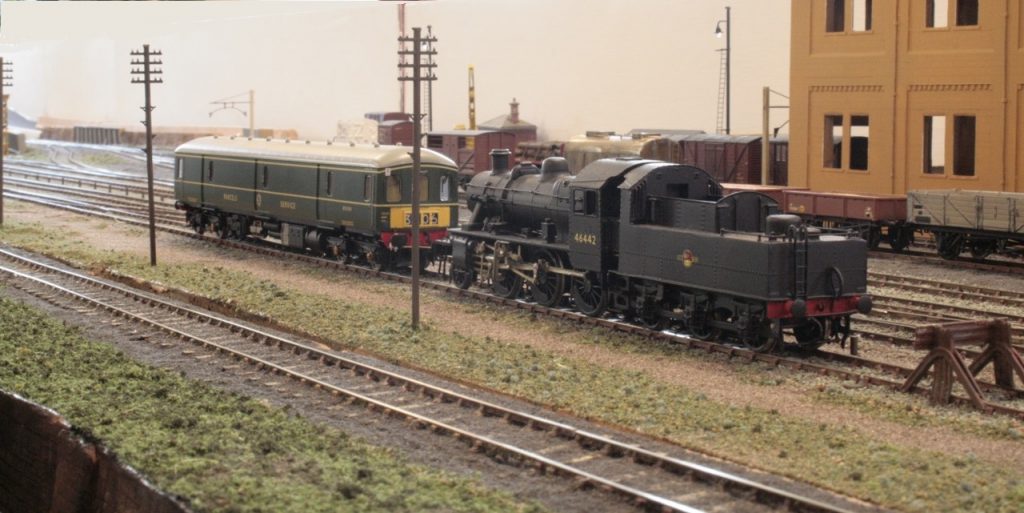 Glaisden depicts a fictitious station on the Calder Valley main line in the early 1960’s. Research into the design of stations, buildings and structures from around the West Yorkshire area has led to the island platform concept being based on Elland while the station buildings are based on Heckmondwike (L&Y). The goods shed and coal drops come from Halifax and the track plan is an amalgamation of features from Elland, Ossett and others.
Glaisden depicts a fictitious station on the Calder Valley main line in the early 1960’s. Research into the design of stations, buildings and structures from around the West Yorkshire area has led to the island platform concept being based on Elland while the station buildings are based on Heckmondwike (L&Y). The goods shed and coal drops come from Halifax and the track plan is an amalgamation of features from Elland, Ossett and others.
Structures are from a number of materials, including plastic, MDF, brass and plaster, some of which may not be that obvious when painted.
The locos and rolling stock are a mixture of modified ready to run, kit built and scratch built and belong to those helping to operate the layout as well as myself. Some are typical of the 1960’s Calder Valley scene, while some rely on a bit of modellers license, for which I hope we will be forgiven.
Hawthorn Dene (N scale, 2mm=1ft, 9mm gauge)
This N-gauge layout repre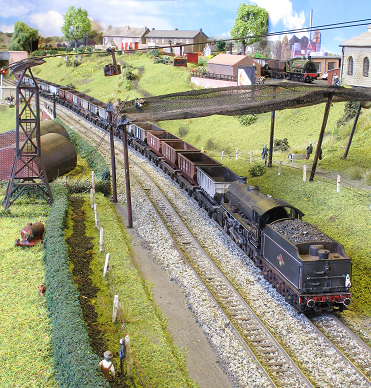 sents the North Eastern Region’s Durham Coast mainline, somewhere around Easington in the late steam/green diesel period. The old Hawthorn Dene Colliery no longer winds coal. Its winding gear has been removed and the shafts fitted with fans. The washery and screens are still in use, mainly preparing household coal for merchants and for the nearby landsale yard. Waste is still sent to be tipped on the beach, both by conveyor belt and aerial ropeway.
sents the North Eastern Region’s Durham Coast mainline, somewhere around Easington in the late steam/green diesel period. The old Hawthorn Dene Colliery no longer winds coal. Its winding gear has been removed and the shafts fitted with fans. The washery and screens are still in use, mainly preparing household coal for merchants and for the nearby landsale yard. Waste is still sent to be tipped on the beach, both by conveyor belt and aerial ropeway.
Colliery locos bring empties from the exchange sidings to the South for weighing and taking on to the screens, while full wagons are removed from the screens , weighed, and taken either to the exchange sidings or North to the Hawthorn complex. Meanwhile the main line sees a procession of expresses, local passenger, fitted goods and coal trains, which seem not to disturb the inhabitants of the pigeon lofts on the bank.
Buildings are typical of the area. The underbridge is based on the one at Easington Colliery- the different parapets are a result of a partial rebuild, possibly following a derailment.
Photo (c) Andy York, (BRM)
Hazeltown (OO, 4mm=1ft, 16.5mm gauge)
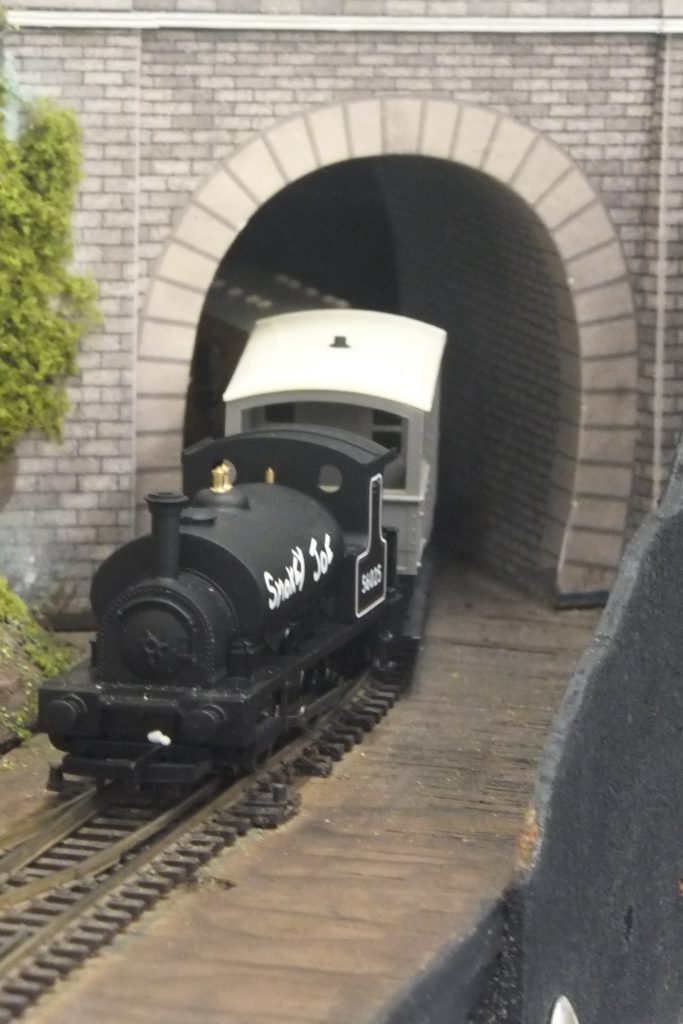 Hazeltown is a small portable layout built by members of the Hazel Grove f& District MRS for children to operate and learn about railways. Based loosely on a combination of features on ‘Underground Ernie ™’ and ‘Thomas the Tank Engine ™’, along with a mixture of standard OO scale and ‘supersize’ figures from the Lego ™ range, this layout has a mixture to get children interested.
Hazeltown is a small portable layout built by members of the Hazel Grove f& District MRS for children to operate and learn about railways. Based loosely on a combination of features on ‘Underground Ernie ™’ and ‘Thomas the Tank Engine ™’, along with a mixture of standard OO scale and ‘supersize’ figures from the Lego ™ range, this layout has a mixture to get children interested.
The track plan is a simple oval with a passing loop at the front by the station and this enables a choice of passenger or goods trains to be run. One train goes round clockwise, while the other anti-clockwise. Children operate the trains using a hand-held controller at the front of the layout.
Obbekær (P87, 3.5mm=1ft, 16.5mm gauge)
Obbekær is unashamedly experimental. After many years of modelling a British subject in P4, I wanted a new challenge, and found it in P87 (finescale HO) modelling, this time with a Danish prototype. Why Danish? Well it has a lot to do with the fact that my home town of Ely is twinned with Ribe in Denmark, so we have been frequent visitors over the years.
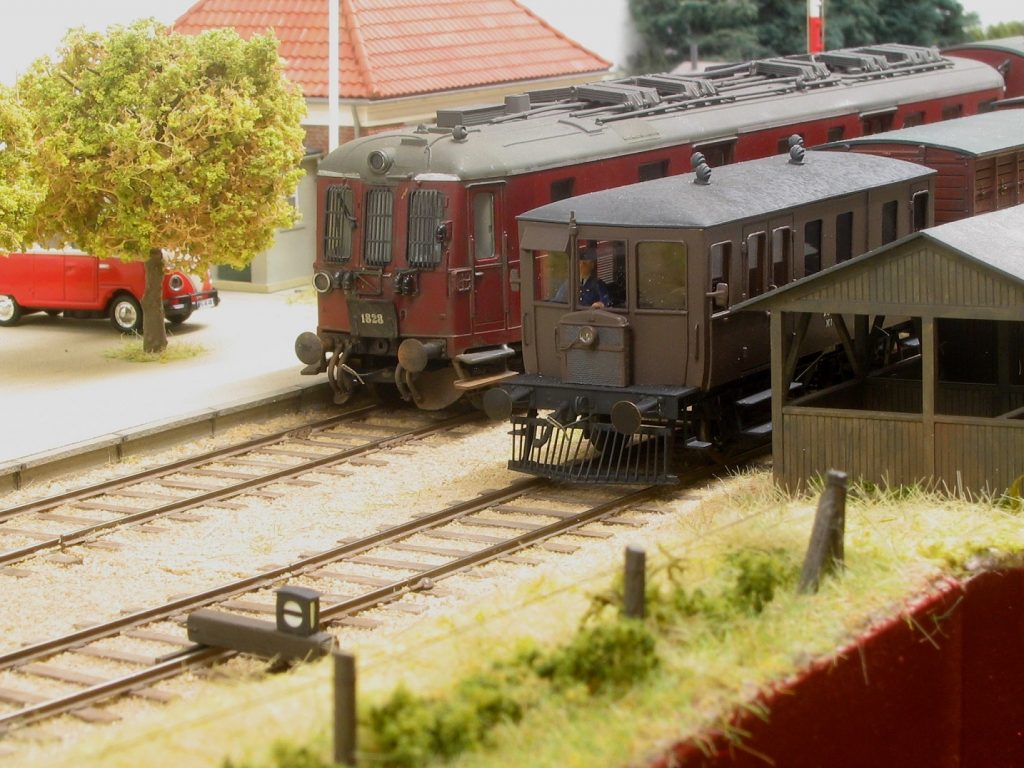 The project has involved designing parts and processes for making track, rolling stock and buildings, and Obbekær is the test bed for all of them. The real location is a village just east of Ribe, and the assumption is that a private railway typical of rural Denmark linked Ribe on the west coast of Jutland with Vojens to the east. Such a line was actually planned in the 1920s, but never built. It’s a sleepy rural station woken several times a day by the passage of a railbus or mixed train, but hopefully a lifelike portrayal of many similar locations in Denmark in the 1950’s.
The project has involved designing parts and processes for making track, rolling stock and buildings, and Obbekær is the test bed for all of them. The real location is a village just east of Ribe, and the assumption is that a private railway typical of rural Denmark linked Ribe on the west coast of Jutland with Vojens to the east. Such a line was actually planned in the 1920s, but never built. It’s a sleepy rural station woken several times a day by the passage of a railbus or mixed train, but hopefully a lifelike portrayal of many similar locations in Denmark in the 1950’s.
The trains are typical of branch line formations on both the private lines and the state railway (DSB) in Jutland, and are either scratchbuilt or heavily modified commercial products.
The layout is relatively new to exhibitions in the UK. We hope the subject is something a little different for the UK audience, and welcome your comments on the layout and the techniques involved.
Photo (c) G Hughes
For further information visit http://www.rmweb.co.uk/community/index.php?/topic/51216-obbekaer-p87/
Old Elms Road (OO, 4mm=1ft, 16.5mm gauge)
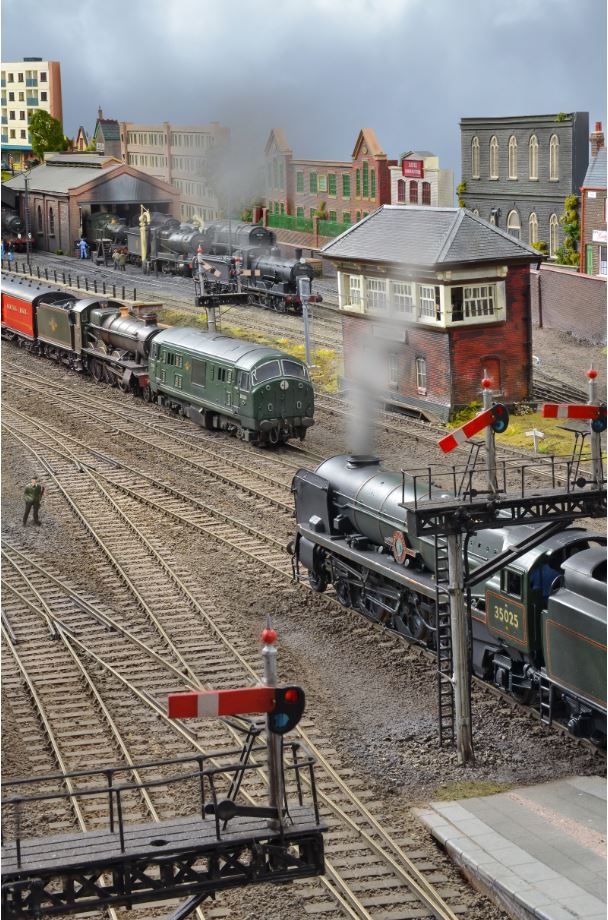 Old Elms Road is a fictitious location based on a station on a Western Region secondary main line near Reading which provides a link between the Western Region in Berkshire and the Southern Region in Hampshire. It features a number of cross country workings between the two regions, a number of local services and a range of freight services. The station features two branch lines, one of which is a single electrified line from the Southern Region. The track layout in the platform area is very loosely based on the track layout at Surbiton
Old Elms Road is a fictitious location based on a station on a Western Region secondary main line near Reading which provides a link between the Western Region in Berkshire and the Southern Region in Hampshire. It features a number of cross country workings between the two regions, a number of local services and a range of freight services. The station features two branch lines, one of which is a single electrified line from the Southern Region. The track layout in the platform area is very loosely based on the track layout at Surbiton
The layout features a locomotive depot which serves the nearby fictitious Old Elms Marshalling yards.
Locomotives and stock are a mixture of kit built, scratch built and detailed ready to run examples and everything is based on rolling stock that would have run in the area between 1956 and 1962. This means that the layout consists of primarily steam hauled trains but there are a handful of very early diesel locomotives and multiple units that can be seen.
The layout features working signals and working road vehicles.
The majority of the buildings seen on the layout are completely built from scratch. The station buildings are based on the former GWR buildings at Tysley
The extensive fiddle yard at the back of the layout is capable of holding up to 50 different trains and gives us the scope to run a wide variety of trains including prototypical length express trains.
Photo (c) Trevor Jones, Hornby Magazine
St Ruth (2FS, 2mm=1ft, 9.42mm gauge)
St Ruth is a 2mmFS layout based on Penzance, with the pre-1938 track plan but wit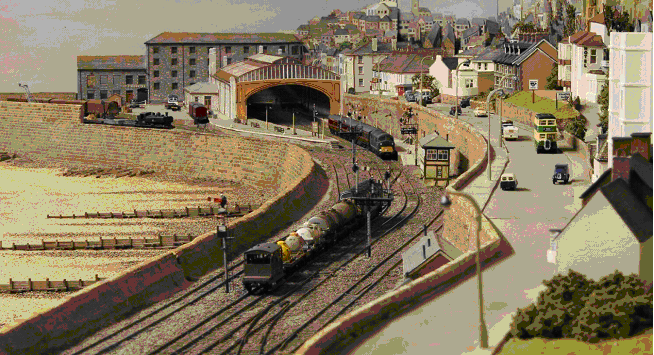 h an additional branch. The stock and operating sequence represent a 24hr weekday period in September 1965, including sleeper, milk, parcels, mail, freight, cross-country and local passenger trains and is compiled form working timetables of the period. Diesel-hydraulics are the main source of power but diesel-electrics and steam are rostered from time to time. Propelling and gravity shunting of empty stock to and from the Long Rock Depot was common due to the lack of head shunt crossovers at Penzance, and these manoeuvres can be seen at St Ruth. The fictional branch to Porthminster is based on the traffic along the St Ives and Hayle b
h an additional branch. The stock and operating sequence represent a 24hr weekday period in September 1965, including sleeper, milk, parcels, mail, freight, cross-country and local passenger trains and is compiled form working timetables of the period. Diesel-hydraulics are the main source of power but diesel-electrics and steam are rostered from time to time. Propelling and gravity shunting of empty stock to and from the Long Rock Depot was common due to the lack of head shunt crossovers at Penzance, and these manoeuvres can be seen at St Ruth. The fictional branch to Porthminster is based on the traffic along the St Ives and Hayle b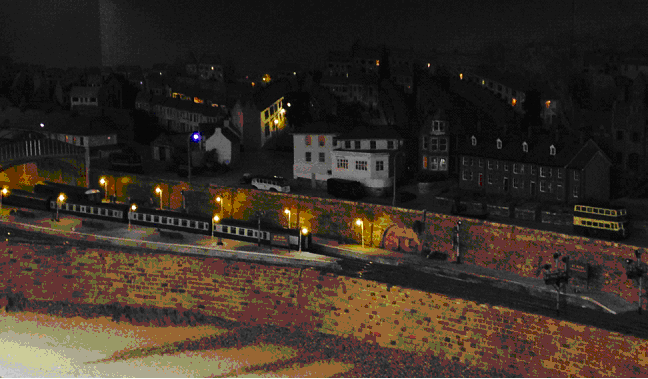 ranches, accessing the Associated Octel Works with bromine, chlorine and fuel traffic.
ranches, accessing the Associated Octel Works with bromine, chlorine and fuel traffic.
The layout was featured in Model Railway Journal issue 239 (2015) and Model Rail 228 (November 2016) .
All the track is built using soldered components and jigs obtained from the 2mm Scale Association. The signals are built from MSE etches (plus a few custom ones) and operated by servos.
The buildings and backscenes are scratchbuilt using mainly card and accurately represent Penzance, measured on site or scaled from photographs from the period where not possible. The sea wall is hand scribed and watercolour painted DAS clay. The beach at Penzance is not very exciting, so St Ruth’s beach has been taken from St Bees, Cumbria.
Some locos have been built from scratch aid kits but most are mainly re-wheeled commercial models. Coaches are likewise, but the goods stock has been built exclusively from 2mm Association kits.
The Sidings (OO, 4mm=1ft, 16.5mm gauge)
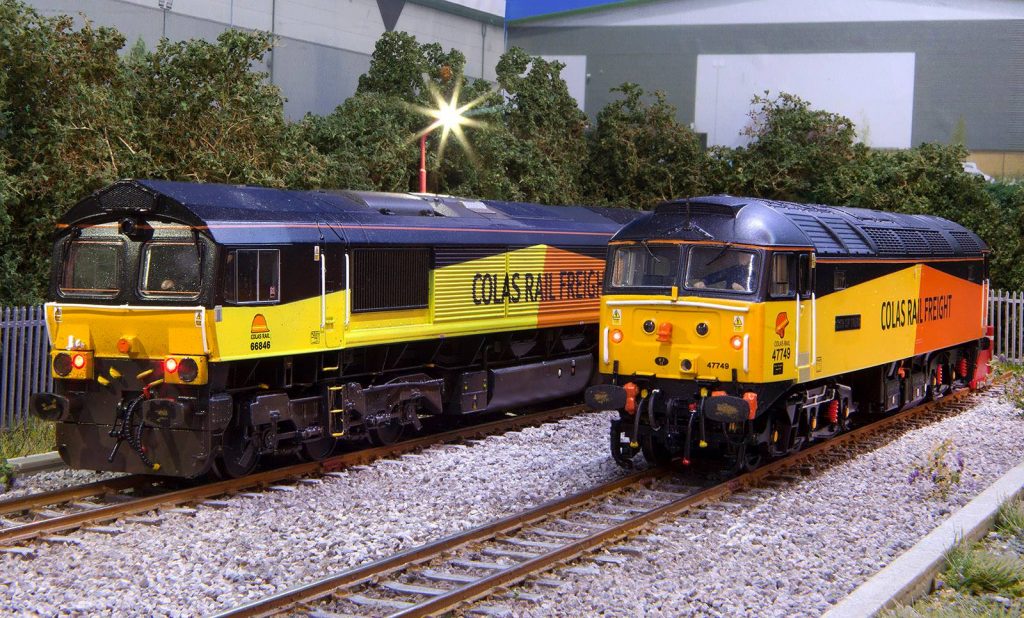 From the makers of Dyserth Road and Holland Park this is a new small OO scale modern image layout measuring 6′ by 1′ mainly to showcase my modern image locos with DRS traction being predominant. Inspired by York Parcel sidings, it could be anywhere in England. It was featured In Rail Express Magazine June 2017.
From the makers of Dyserth Road and Holland Park this is a new small OO scale modern image layout measuring 6′ by 1′ mainly to showcase my modern image locos with DRS traction being predominant. Inspired by York Parcel sidings, it could be anywhere in England. It was featured In Rail Express Magazine June 2017.
Underhill Town (OO9, 4mm=1ft, 9mm gauge)
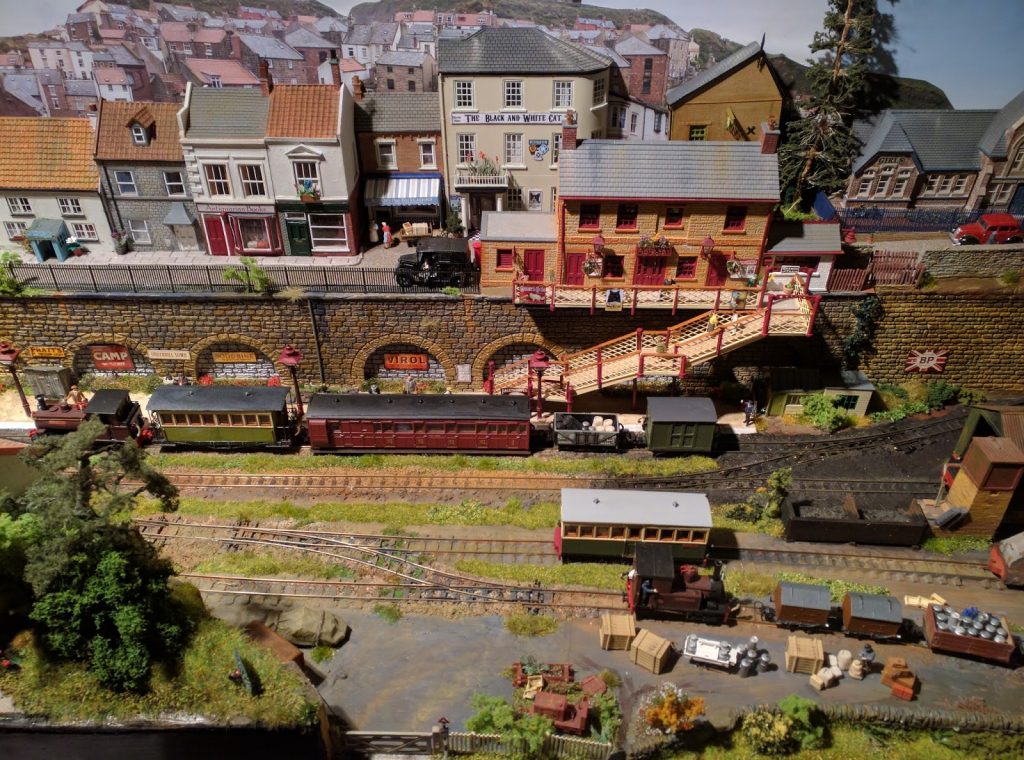
Underhill Town is the terminus of the branch line from Port Lucy to Underhill on the Stoner Railway. Built in 1883, the Stoner Railway connects the principal settlements and quarries on the Isle of Stoner, an idyllic island, about one hundred miles to the south of Cornwall, where the sun always shines in a perpetual summer afternoon of 1964.
The railway is presented in three separate scenes along the branch, from the outskirts of Port Lucy, with its cheese factory and herb nursery, along the coast to Rocky Beach Halt, past the Town Quarry and into the terminus in the picturesque village of Underhill.
Further information about the Isle of stoner and its railway can be found at http://isleofstoner.blogspot.co.uk/
Villefranche-la-Chapelle (HO, 3.5mm=1ft, 16.5mm gauge)
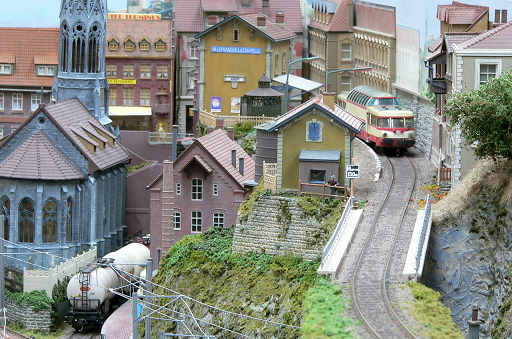 Villefranche-la-Chapelle is a small layout designed to show a shunting yard in a fictional French town in the 1990s, serving a few industries at the same time. The area to the right was possibly once a quarry, but is now used to handle local timber and stone traffic, while the sidings to the left serve the industries of the small town on the hill behind. There’s also a higher level line in and out of a platform, to allow a DMU or two to be run.
Villefranche-la-Chapelle is a small layout designed to show a shunting yard in a fictional French town in the 1990s, serving a few industries at the same time. The area to the right was possibly once a quarry, but is now used to handle local timber and stone traffic, while the sidings to the left serve the industries of the small town on the hill behind. There’s also a higher level line in and out of a platform, to allow a DMU or two to be run.
The idea was to create the atmosphere of a typical French small town and its still-active rail system, something that had disappeared from the British rail scene in the 1960s, but which I had enjoyed seeing in France for many years afterwards.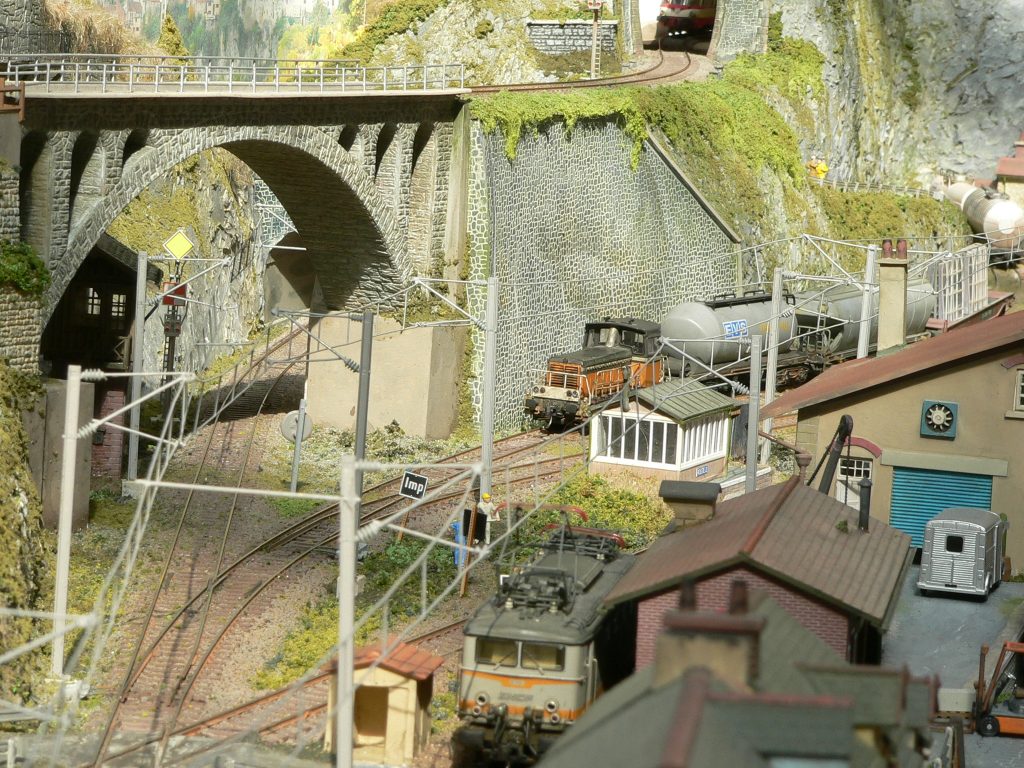
With the addition of catenary in parts of the shunting yard, it’s now possible to see AC or DC electric engines, as well as diesel power.
Villefranche-la-Chapelle is owned by the Carshalton and sutton Model Railway Club and further details may be found on their website www.csmrc.co.uk
Photos (c) Graham Broad
